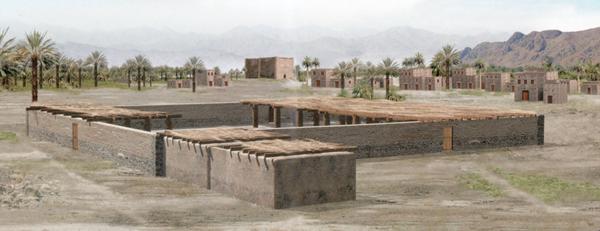The original mosque was built by Prophet Muhammad (s.a.w), next to the house where he settled after his journey to al-Madinah in 622 AD. The original mosque was an open-air building with a raised platform for the reading of the Qur'an. It was a rectangular enclosure of 30 m × 35 m (98 ft × 110 ft), built with palm trunks and mud walls, and accessed through three doors: Bab Rahmah to the south, Bab Jibril to the west and Bab al-Nisa' to the east. The basic plan of the building has since been adopted in the building of other mosques throughout the world.
Inside, Muhammad (s.a.w) created a shaded area to the south called the suffah and aligned the prayer space facing north towards Jerusalem. When the qibla (prayer direction) was changed to face the Kaaba in Mecca, the mosque was re-oriented to the south. The mosque also served as a community center, a court, and a religious school. Seven years later (629 AD/7 AH), the mosque was doubled in size to accommodate the increasing number of Muslims.

Subsequent Islamic rulers continued to enlarge and embellish the mosque over the centuries. In 707, Umayyad Caliph Al-Walid ibn Abd al-Malik (705-715) replaced the old structure and built a larger one in its place, incorporating the tomb of Muhammad (s.a.w). This mosque was 84 m × 100 m (280 ft × 330 ft) in size, with stone foundations and a teak roof supported on stone columns. The mosque walls were decorated with mosaics by Coptic and Greek craftsmen, similar to those seen in the Umayyad Mosque in Damascus and the Dome of the Rock in Jerusalem (built by the same caliph). The courtyard was surrounded by a gallery on four sides, with four minarets on its corners. A mihrab topped by a small dome was built on the qibla wall.
Abbasid Caliph al-Mahdi (775-785) replaced the northern section of Al-Walid's mosque between 778 and 781 to enlarge it further. He also added 20 doors to the mosque; eight on each of the east and west walls, and four on the north wall.
During the reign of the Mamluk Sultan Qalawun, a dome was erected above the tomb of Muhammad (s.a.w) and an ablution fountain was built outside of Bab al-Salam. Sultan Al-Nasir Muhammad rebuilt the fourth minaret that had been destroyed earlier. After a lightning strike destroyed much of the mosque in 1481, Sultan Qaitbay rebuilt the east, west and qibla walls.
Madina Munawwarah Photo Gallery
 Subsequent Islamic rulers continued to enlarge and embellish the mosque over the centuries. In 707, Umayyad Caliph Al-Walid ibn Abd al-Malik (705-715) replaced the old structure and built a larger one in its place, incorporating the tomb of Muhammad (s.a.w). This mosque was 84 m × 100 m (280 ft × 330 ft) in size, with stone foundations and a teak roof supported on stone columns. The mosque walls were decorated with mosaics by Coptic and Greek craftsmen, similar to those seen in the Umayyad Mosque in Damascus and the Dome of the Rock in Jerusalem (built by the same caliph). The courtyard was surrounded by a gallery on four sides, with four minarets on its corners. A mihrab topped by a small dome was built on the qibla wall.
Subsequent Islamic rulers continued to enlarge and embellish the mosque over the centuries. In 707, Umayyad Caliph Al-Walid ibn Abd al-Malik (705-715) replaced the old structure and built a larger one in its place, incorporating the tomb of Muhammad (s.a.w). This mosque was 84 m × 100 m (280 ft × 330 ft) in size, with stone foundations and a teak roof supported on stone columns. The mosque walls were decorated with mosaics by Coptic and Greek craftsmen, similar to those seen in the Umayyad Mosque in Damascus and the Dome of the Rock in Jerusalem (built by the same caliph). The courtyard was surrounded by a gallery on four sides, with four minarets on its corners. A mihrab topped by a small dome was built on the qibla wall.









